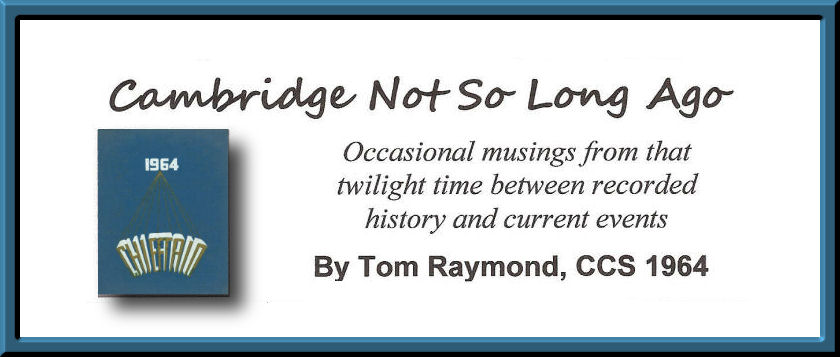|
The Delaware & Hudson Railroad
|
|
One of the last passenger excursions through the lower Cambridge Valley, September 1975 Back a generation or two, what son or daughter of Cambridge, who’d enlisted or was drafted into the Armed Forces, didn’t raise his or her right hand and swear allegiance to the Constitution of the United States at the federal facility in downtown Albany, in the shadows of the Delaware & Hudson Railroad Building? Then, if you were bound for glory in bell bottoms over the deep blue sea, you rode the overnight Empire State Express (New York Central) from that classic neo-Gothic-Dutch structure out to Boot Camp at Great Lakes Naval Training Center just north of Chicago. But the D&H – conceived in the 1820s to connect the two rivers with a canal, Kingston to Port Jervis, to bring anthracite coal to Eastern cities, and later developed into the D&H RR – has also made for other lasting impressions for many a Cambridge resident with an active rail spur running for decades up the Cambridge Valley from the junction at Eagle Bridge. In fact, tracks were laid for the first time through the area in 1851, the same year a new process for producing steel in high volume was discovered (by William Kelly, but later patented by Henry Bessemer); the nation’s railroads were a beneficiary of the steel which made for more reliable and safer rails, as the reach from Washington County was extended in the 1850s across the nation, into the Deep South, and west to the terminus at Omaha. Since 1991 the D&H has been a subsidiary of the Canadian Pacific Railway.
On September 20, 1975, for the first time in a decade, a Delaware & Hudson excursion train rolled through the area on its way to view the fall colors … before the term “leaf-peeping” entered the tour trade lexicon a few years later. That trek was one of the very last passenger trips along the stretch of rail below Cambridge since the ballast, track, and trestles had aged, with minimal upkeep from the economic reality of the day, limiting the speed to a chug-chug-chug of about 10 MPH. A series of snapshots by Col. Charles W. Raymond II captured the event on a clear day with high blue skies. In the first view, the train, powered by a pair of Baldwin “Sharknose” “A” locomotives configured back-to-back, is seen pulling into Eagle Bridge. These were a pair of RF-16 diesel-electrics, with unit #1205 leading #1216, both of which were acquired from New York Central in 1974 and used for freight service until ‘78. The RF-16 was the more common Sharknose manufactured by Baldwin at its Philadelphia works in the early ‘50s. A total of 109 “A” units (with cabs) of this class and 51 companion “B” units (no cabs) had been produced from 1950-53, rated at a modest 1600 horsepower. Compare this to the DR-6-4-2000 (1948), with only 18 “A” and 9 “B” units produced, yet each cranking out a hefty 2000 HP; and the DR-4-4-1500 (1949-50), with 36 “A” and 36 “B” units, at 1500 HP.
In late morning that late summer day, the combine of engines, a baggage car, several coaches, and an observation car, paused at Eagle Bridge for two short minutes, then proceeded onward. It was switched off the main line (Boston and Maine) and rumbled out over the Hoosic River trestle just above the confluence with the Owlkill, as seen in the next photos. Rail buffs had an easy time chasing their target up Route 22, paralleling the Owlkill and the rail route. They were waiting for it as it entered Cambridge about where the old creamery tower had stood for over five decades – but which had come down in a cloud of dust just a few days before. The train eased along the mid-village rails, crossing Main Street at the Cambridge Hotel and the long-abandoned train station, which had since been revived as one or another commercial venture unrelated to its heritage. Sadly, though, in a Rodney Dangerfield moment – “No respect!” – the train did NOT pause in Cambridge (following three photos), but rambled ever northward and out of town, with tourists on the observation car’s platform nodding to folks on the old freight yard dock. In olden times, a whistle-stop could have been in order, and a politician or two might have offered a platitude or two to the “high information” voters of that earlier age, days long gone (in more than one sense, for sure.)
After passing over a few more thousand oily, pungent railroad ties and rusting steel spikes, about four or five statue miles or so up the road, the aging yet venerable D&H #1205 and its brother eased their charges, the several dozen camera-clicking, paying fares, into the Shushan yard and then on past the 107-foot Howe truss that is the Rexleigh Covered Bridge (1874). At that crossroads of two common modes of transport, of old heavy metal and newer steel-belted radials, Mrs. Charles (Marcia) Raymond and her friend Lucile Palmer paused to reflect on this passing moment in history. A moment of two stalwart American symbols saluting one another, icons that live on only in the minds of many today, but are occasionally also recaptured and retained by the sweat, skill, and love of the dedicated. Those who truly honor their ancestors, perhaps a gentle reflection in one sense of Scripture: “Honor thy father and thy mother ….” (Exodus 20:12).
Sources: Raymond family photo archives; A Pictorial Guide to the Covered Bridges of Lower Washington County, New York, Past and Existing (Robert W. Raymond, 1970.) Contact: tmraymond4@gmail.com.
Back to CAMBRIDGE NOT SO LONG AGO INDEX
|








